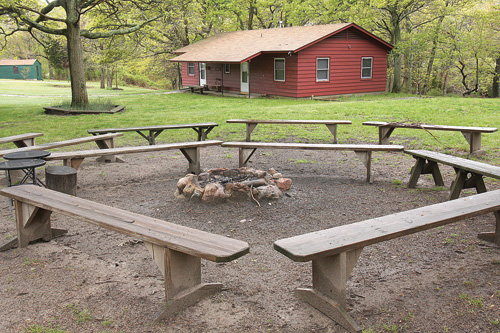It’s not just another summer at Camp DeWolfe in Wading River

There’s a 26-acre spiritual oasis on a cliff overlooking Long Island Sound in Wading River. Signs for Camp DeWolfe are peppered along Wading River Road, directing motorists up North Side Road to the 65-year-old Episcopal summer camp.
A little more than a year ago, when Lawrence Provenzano became Long Island’s Episcopal bishop, he made it a mission of the Diocese of Long Island to revitalize Camp DeWolfe, spending $1.6 million to upgrade its dining hall, meeting hall, chapel and cabins. That work is almost complete and, on Sunday, June 3, at 4:30 p.m., a public celebration will mark the camp’s revitalization.
Around the time renovations began, the church brought in new program director Emma Tees, who is helping to raise public awareness about the camp, which is open year-round for individual and group retreats and conferences, as well as for a traditional summer camp.
Camp DeWolfe was named for Episcopal Bishop James Pernette DeWolfe, who served Long Island in the 1950s, Ms. Tees said during a recent tour of the property. It was founded in 1947, not long after the two houses on the property had been used by Nazi spies who reported on the goings-on of submarine activity out of New London, Conn. Ms. Tees said the spies were intercepted by the Americans, who used them to send faulty information back to Germany toward the end of the war.
When the diocese first bought the property, campers stayed in tents on platforms. The meeting and mess halls and St. Luke’s Chapel weren’t added until the 1960s. By the 1990s, heated cabins with half-baths and a swimming pool were built.
“It became luxurious camping,” said Ms. Tees. “Groups would come from upstate, Long Island and the city.”
She said the camp is now used for family reunions, weddings and meetings of nature, art and yoga groups, as well as for a traditional summer camp.
The recent renovation, which included updating the heating and cooling systems, removing asbestos flooring and installing new kitchen equipment, was paid for through a trust established when the diocese sold a 13-acre portion of the original property several years ago.
Tempur-Pedic has also donated mattresses for all the cabins at the camp, and a high and low ropes course has been added.
“We want to offer that to the community for team-building exercises,” Ms. Tees said.
She is developing the camp’s summer activities “to make sure the programs are relevant in the global society.”
For example, to help campers understand the worldwide scarcity of clean water, they’ll walk the trails with buckets of water to see what daily life is like for kids in developing countries.
“We’ve been really blessed here,” she said. “We want to learn how can we bless others.”
The camp is also investing in canoes, Sunfish and kayaks to be used on the camp’s quarter-mile of Soundfront beach.
“In the past we hadn’t been as much on the Sound as we could be,” Ms. Tees said. “We should use the resources we have here.”
After Bishop Provenzano came on board and the diocese was considering its options for the site, the property was appraised at $9 million. The diocese could have sold the property, she said, but the bishop had seen how much summer camp experiences had helped his own children become self-reliant.
“The waterfront is valuable, but so are young people,” she said. “We want to be a ministry to the local community. We want to serve as a rallying spot.”







